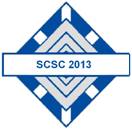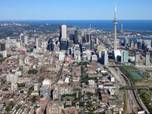|
Summer computer simulation conference |
|
July 7-10 2013, Toronto, Canada |
|
P.O. Box 17900 |

|
SCSC Call for Papers Computer Graphics for Simulation Workshop/Paper Track at the Summer Computer Simulation Conference
Chair: John F. Richardson††††††††††††††††††††††††† SPAWAR Systems Center PACIFIC†††††††††††††††††††††††††††††† San Diego, California
Deadlines for papers submission
Track Description
Simulations can consist of focused physical simulations to complex interconnected systems. Simulations can be used to produce numbers. Some simulations can produce theories of human behaviors. Other simulations test security while others investigate industrial control. In some cases the result is just a number or statistic. In many cases, the result is anthropomorphic. Many simulations use graphics to present the results. Many simulations use virtual objects to represent the input to simulations. In many cases, the simulation must be visualized to reveal useful patterns in processes and models. This workshop/paper track is designed to elicit papers that present novel results in simulation visualization. The workshop/paper track focuses on several topic areas. The General Computer Graphics topic area is designed to solicit papers that apply state of the art graphics techniques to visualizing simulation results and simulation virtual environments. The Web3D / WebGL / HTML5 topic area is designed to extract from the research community, state of the art techniques for visualizing distributed simulations. Many physically based simulations require solutions of complex systems of equations that must have efficient computational grids to produce realistic results with minimal computer resources. The 3-D modeling and animation systems topic is an application topic that asks how mature and existing modeling and animation systems can be integrated into the task of visualizing simulations. The art and esthetics topic invites researchers to present their work on pure art applied to simulation visualization. Many of the topic areas involve advanced computer graphics techniques and in some cases, art of high caliber. Authors are encouraged to attach supplementary high-resolution renderings to their submissions for presentation in an exhibition at the conference [Fame and Glory is the reward].† WebGL and HTML5 is a new hot topic in Computer Graphics heavily promoted at SIGGRAPH 2010.
Technical papers are solicited, but not limited to the following topics:
General Computer Graphics ∑ DEVS, simulation methodologies and Computer Graphics ∑ Rendering strategies and algorithms for architecture ∑ Visualizing deformation of mechanical and civil engineering structures resulting from simulations ∑ Modeling and animation of machinery simulations ∑ Modeling and animation support for Industrial Processes ∑ Solid modeling for simulation ∑ Visualizing gas, explosion and fluid simulation ∑ Volume visualization for simulation (medical, structural, geological, fluids, gases) ∑ Visualizing terrain effects on simulations (fluid, telecommunications, transport, security, military) ∑ Transportation visualization (structures, flight, vehicles, subways, tunnels, construction, security, military) ∑ Level of detail strategies for simulation visualization ∑ Massive virtual environments ∑ Visualization of mathematical objects ∑ Visualization of chemical and biological Objects ∑ Visualization of astronomical simulations ∑ Time and memory complexity of scientific visualizations ∑ Visualizing and graphing simulation data ∑ Verifying Accuracy of visualizations against simulation results ∑ Interaction techniques and haptic devices for simulation ∑ Visualizing damage to military and civilian transport ∑ Realistic lighting for simulation
Web3D / WebGL / HTML5 for Simulation∑ VRML/X3D for simulation ∑ WebGL technology and WebGL for Distributed Simulations ∑ COLLADA / OSG / KML / Game simulations / DEVS† and CG / Coupled DEVS and CG ∑ Scenegraphs and strategies for simulation visualization optimization ∑ Collaborative medical simulation ∑ Data acquisition for simulation ∑ Distributed military simulation visualization ∑ Interoperability between military and civilian file formats ∑ NVIDIA CUDA, OpenCL [Open Compute Language for CPU/GPU Scheduling]
Computational Grids for Simulation∑ 2-D and 3-D irregular grids for simulation ∑ Adaptive grids for simulation ∑ Parallel algorithms for computational grids ∑ Grids for very large virtual environments
3-D Modeling and Animation Systems use in Simulation [including DEVS]∑ 2-D and 3-D commercial modeling and animation ∑ 2-D and 3-D open source modeling and animation ∑ Use of video to visualize simulation ∑ Video input to simulations ∑ 2-D drawing and sketching for use in simulation ∑ Use of commercial and open source export formats in simulation
Art and Esthetics in Simulation∑ Art and design strategies for simulated objects ∑ Color ∑ Creating realistic textures for simulation visualization ∑ Art in constructing virtual environments
Authors must strictly follow SCSC guidelines for paper submission. |



|
SPONSORED BY |